Auditing Report: Analysis of IAG's Financial Performance
VerifiedAdded on 2020/02/24
|26
|5520
|47
Report
AI Summary
This report provides a comprehensive auditing analysis of Insurance Australia Group (IAG), a multinational insurance company. It begins with an overview of IAG's business operations, investment activities, and financing activities, followed by an examination of the insurance industry, including its size, growth, supply chain, major players, and critical success factors. The report then delves into the legal and external environmental factors affecting IAG, utilizing PEST, Porter's Five Forces, and SWOT analyses to assess the company's position. Further sections cover IAG's objectives, strategies, and business risk assessment, alongside an analysis of analytical procedures used to evaluate the entity's performance and management and governance. The report concludes with a summary of key findings and recommendations based on the audit analysis.
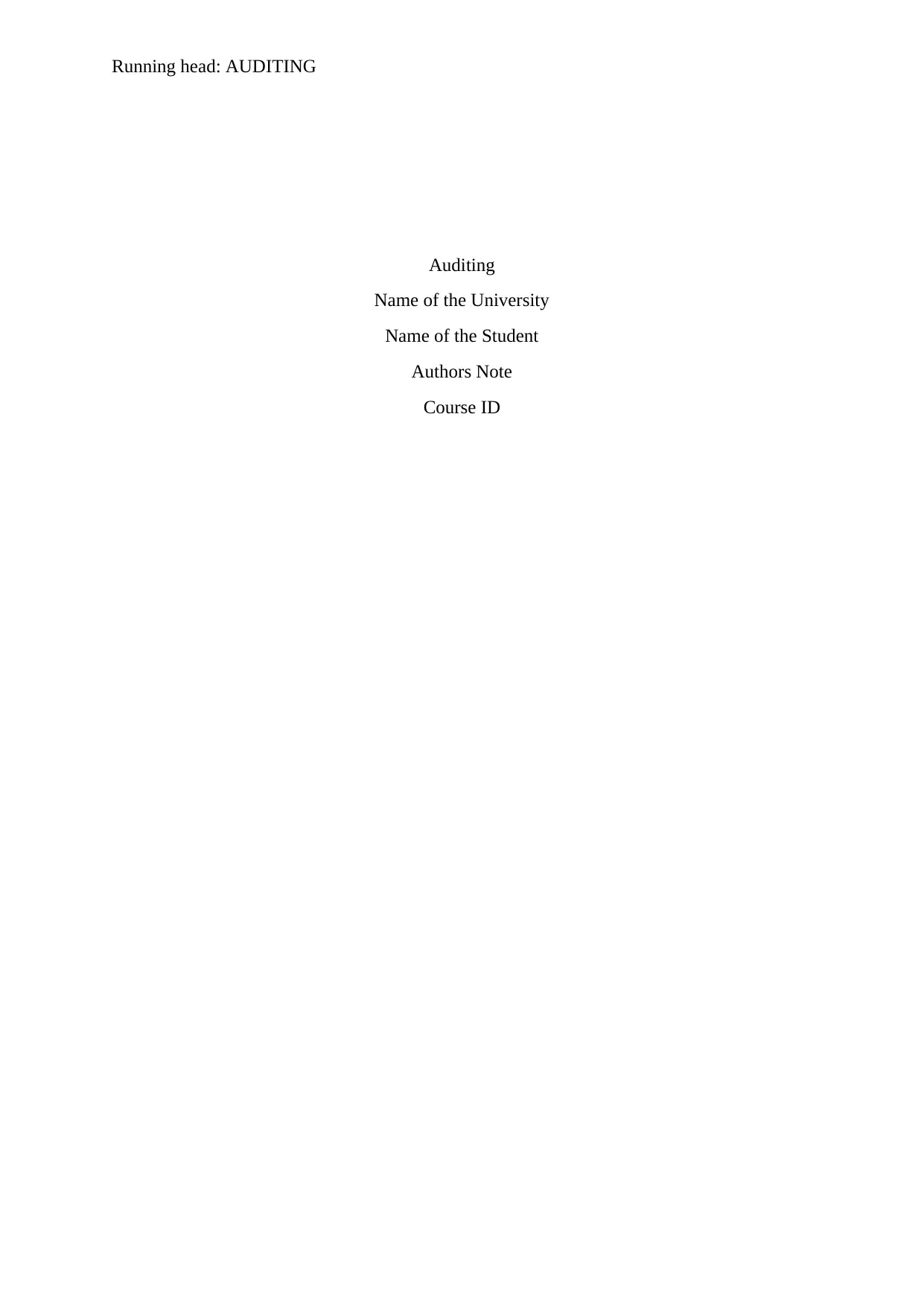
Running head: AUDITING
Auditing
Name of the University
Name of the Student
Authors Note
Course ID
Auditing
Name of the University
Name of the Student
Authors Note
Course ID
Paraphrase This Document
Need a fresh take? Get an instant paraphrase of this document with our AI Paraphraser

1AUDITING
Table of Contents
Introduction:...............................................................................................................................2
Part 1: Understanding the Nature of the Entity:.........................................................................2
Business Operations:..................................................................................................................2
Investment and investment activities:........................................................................................2
Financing and Financing Activities:..........................................................................................3
Financial reporting practices:.....................................................................................................3
Part 2: Understanding the industry:............................................................................................3
Industry size:..............................................................................................................................3
Industry Growth:........................................................................................................................4
Supply chain:..............................................................................................................................4
Major Players:............................................................................................................................4
Market Share of Industry Players:..............................................................................................5
Critical success factors:..............................................................................................................6
Major threats:.............................................................................................................................6
Part 3: Understanding the Legal Environment...........................................................................6
Part 4: Understanding the external environment factors:...........................................................7
PEST Analysis...........................................................................................................................7
Porters Five Forces Analysis:.....................................................................................................9
SWOT Analysis:......................................................................................................................11
Part 5: Understanding objectives, strategies and Assessing Business Risk:............................12
Table of Contents
Introduction:...............................................................................................................................2
Part 1: Understanding the Nature of the Entity:.........................................................................2
Business Operations:..................................................................................................................2
Investment and investment activities:........................................................................................2
Financing and Financing Activities:..........................................................................................3
Financial reporting practices:.....................................................................................................3
Part 2: Understanding the industry:............................................................................................3
Industry size:..............................................................................................................................3
Industry Growth:........................................................................................................................4
Supply chain:..............................................................................................................................4
Major Players:............................................................................................................................4
Market Share of Industry Players:..............................................................................................5
Critical success factors:..............................................................................................................6
Major threats:.............................................................................................................................6
Part 3: Understanding the Legal Environment...........................................................................6
Part 4: Understanding the external environment factors:...........................................................7
PEST Analysis...........................................................................................................................7
Porters Five Forces Analysis:.....................................................................................................9
SWOT Analysis:......................................................................................................................11
Part 5: Understanding objectives, strategies and Assessing Business Risk:............................12
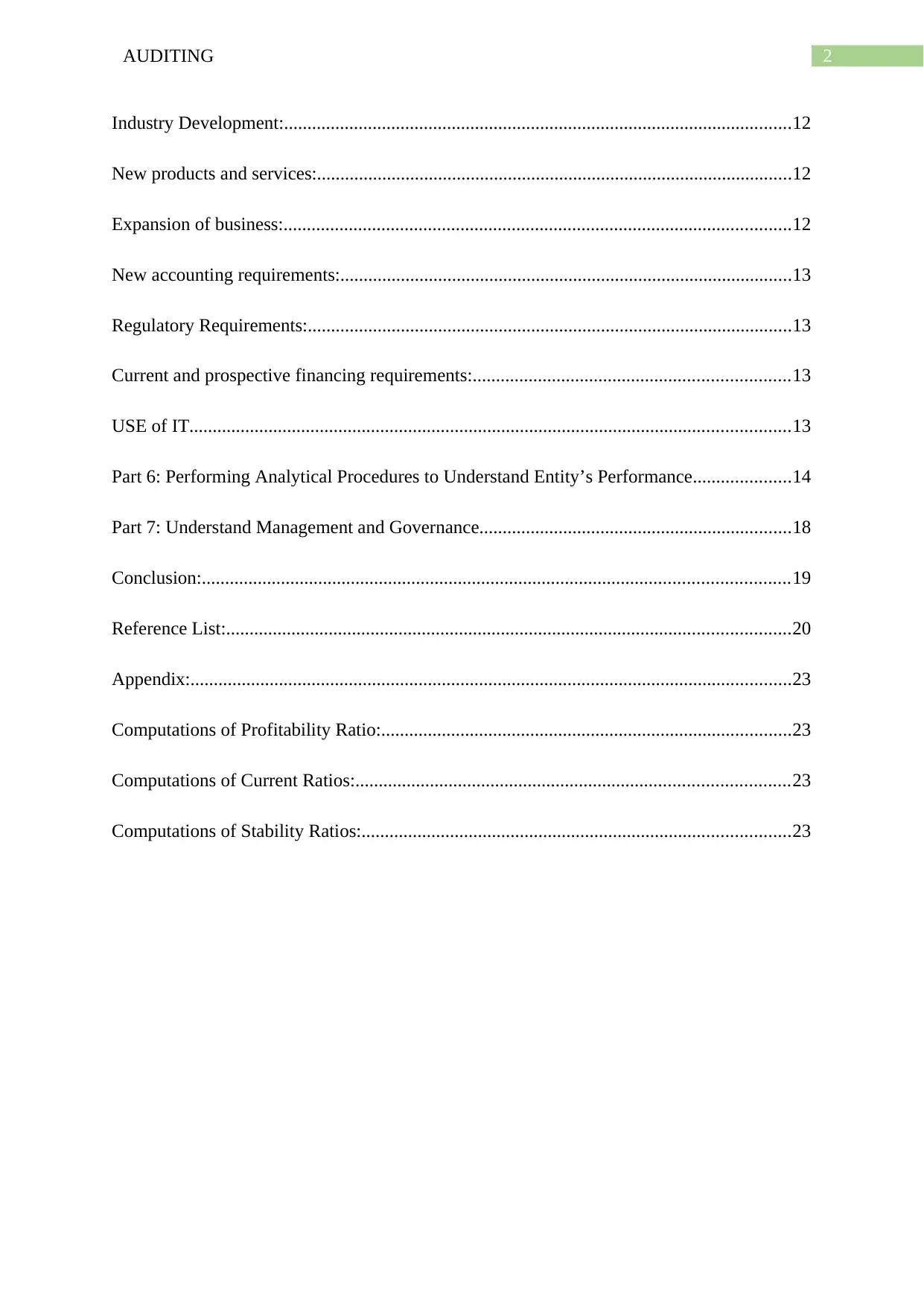
2AUDITING
Industry Development:.............................................................................................................12
New products and services:......................................................................................................12
Expansion of business:.............................................................................................................12
New accounting requirements:.................................................................................................13
Regulatory Requirements:........................................................................................................13
Current and prospective financing requirements:....................................................................13
USE of IT.................................................................................................................................13
Part 6: Performing Analytical Procedures to Understand Entity’s Performance.....................14
Part 7: Understand Management and Governance...................................................................18
Conclusion:..............................................................................................................................19
Reference List:.........................................................................................................................20
Appendix:.................................................................................................................................23
Computations of Profitability Ratio:........................................................................................23
Computations of Current Ratios:.............................................................................................23
Computations of Stability Ratios:............................................................................................23
Industry Development:.............................................................................................................12
New products and services:......................................................................................................12
Expansion of business:.............................................................................................................12
New accounting requirements:.................................................................................................13
Regulatory Requirements:........................................................................................................13
Current and prospective financing requirements:....................................................................13
USE of IT.................................................................................................................................13
Part 6: Performing Analytical Procedures to Understand Entity’s Performance.....................14
Part 7: Understand Management and Governance...................................................................18
Conclusion:..............................................................................................................................19
Reference List:.........................................................................................................................20
Appendix:.................................................................................................................................23
Computations of Profitability Ratio:........................................................................................23
Computations of Current Ratios:.............................................................................................23
Computations of Stability Ratios:............................................................................................23
⊘ This is a preview!⊘
Do you want full access?
Subscribe today to unlock all pages.

Trusted by 1+ million students worldwide
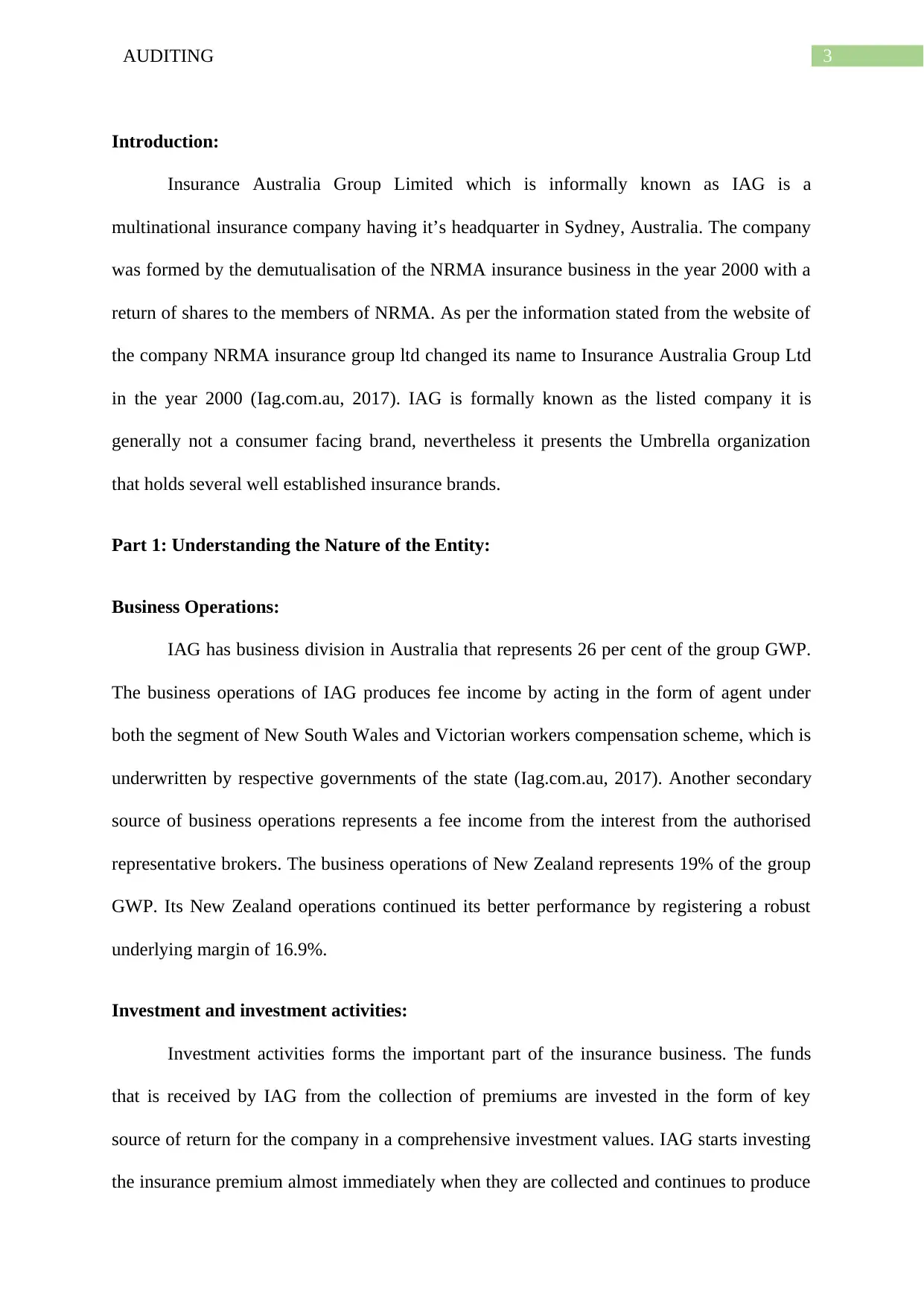
3AUDITING
Introduction:
Insurance Australia Group Limited which is informally known as IAG is a
multinational insurance company having it’s headquarter in Sydney, Australia. The company
was formed by the demutualisation of the NRMA insurance business in the year 2000 with a
return of shares to the members of NRMA. As per the information stated from the website of
the company NRMA insurance group ltd changed its name to Insurance Australia Group Ltd
in the year 2000 (Iag.com.au, 2017). IAG is formally known as the listed company it is
generally not a consumer facing brand, nevertheless it presents the Umbrella organization
that holds several well established insurance brands.
Part 1: Understanding the Nature of the Entity:
Business Operations:
IAG has business division in Australia that represents 26 per cent of the group GWP.
The business operations of IAG produces fee income by acting in the form of agent under
both the segment of New South Wales and Victorian workers compensation scheme, which is
underwritten by respective governments of the state (Iag.com.au, 2017). Another secondary
source of business operations represents a fee income from the interest from the authorised
representative brokers. The business operations of New Zealand represents 19% of the group
GWP. Its New Zealand operations continued its better performance by registering a robust
underlying margin of 16.9%.
Investment and investment activities:
Investment activities forms the important part of the insurance business. The funds
that is received by IAG from the collection of premiums are invested in the form of key
source of return for the company in a comprehensive investment values. IAG starts investing
the insurance premium almost immediately when they are collected and continues to produce
Introduction:
Insurance Australia Group Limited which is informally known as IAG is a
multinational insurance company having it’s headquarter in Sydney, Australia. The company
was formed by the demutualisation of the NRMA insurance business in the year 2000 with a
return of shares to the members of NRMA. As per the information stated from the website of
the company NRMA insurance group ltd changed its name to Insurance Australia Group Ltd
in the year 2000 (Iag.com.au, 2017). IAG is formally known as the listed company it is
generally not a consumer facing brand, nevertheless it presents the Umbrella organization
that holds several well established insurance brands.
Part 1: Understanding the Nature of the Entity:
Business Operations:
IAG has business division in Australia that represents 26 per cent of the group GWP.
The business operations of IAG produces fee income by acting in the form of agent under
both the segment of New South Wales and Victorian workers compensation scheme, which is
underwritten by respective governments of the state (Iag.com.au, 2017). Another secondary
source of business operations represents a fee income from the interest from the authorised
representative brokers. The business operations of New Zealand represents 19% of the group
GWP. Its New Zealand operations continued its better performance by registering a robust
underlying margin of 16.9%.
Investment and investment activities:
Investment activities forms the important part of the insurance business. The funds
that is received by IAG from the collection of premiums are invested in the form of key
source of return for the company in a comprehensive investment values. IAG starts investing
the insurance premium almost immediately when they are collected and continues to produce
Paraphrase This Document
Need a fresh take? Get an instant paraphrase of this document with our AI Paraphraser
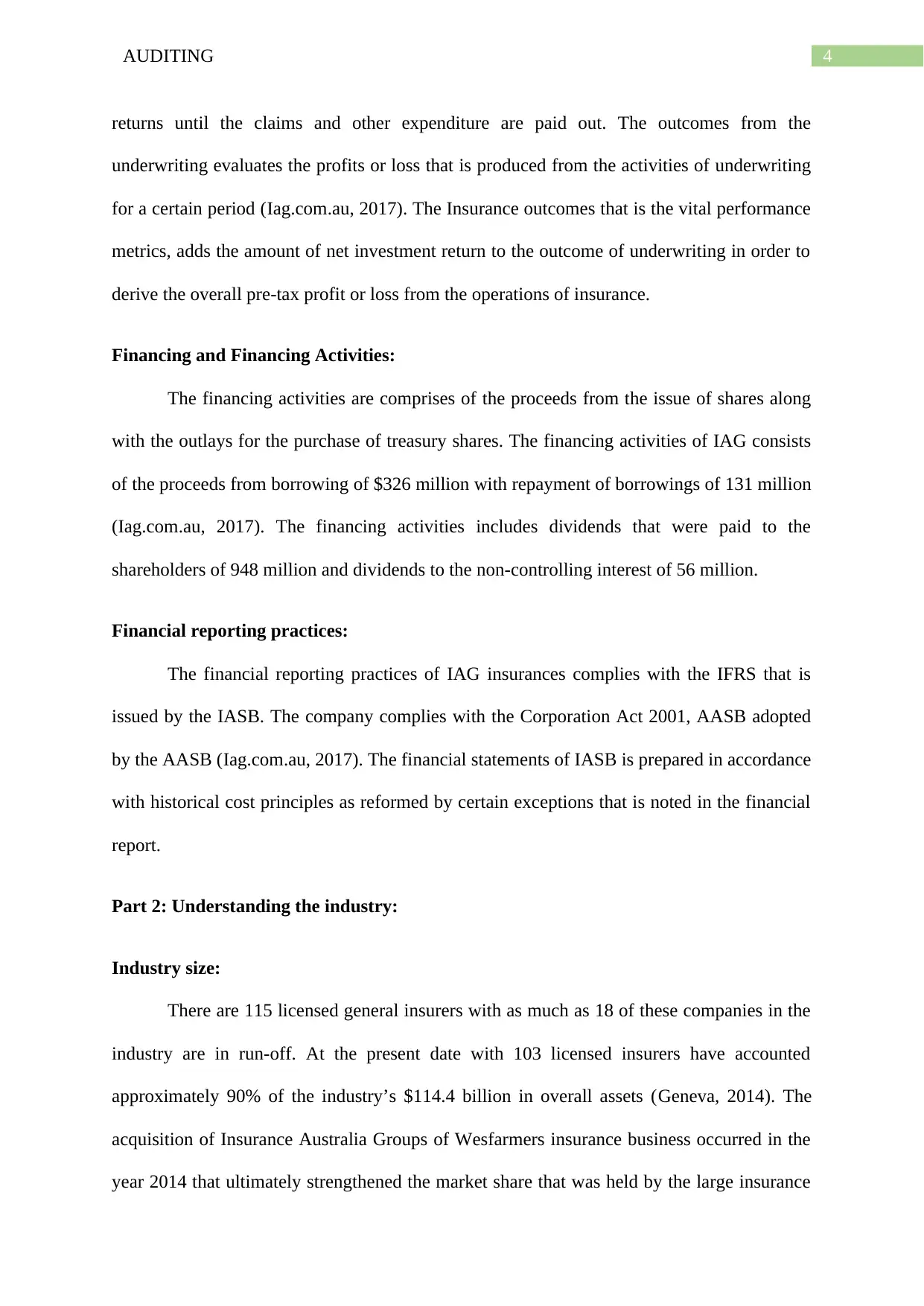
4AUDITING
returns until the claims and other expenditure are paid out. The outcomes from the
underwriting evaluates the profits or loss that is produced from the activities of underwriting
for a certain period (Iag.com.au, 2017). The Insurance outcomes that is the vital performance
metrics, adds the amount of net investment return to the outcome of underwriting in order to
derive the overall pre-tax profit or loss from the operations of insurance.
Financing and Financing Activities:
The financing activities are comprises of the proceeds from the issue of shares along
with the outlays for the purchase of treasury shares. The financing activities of IAG consists
of the proceeds from borrowing of $326 million with repayment of borrowings of 131 million
(Iag.com.au, 2017). The financing activities includes dividends that were paid to the
shareholders of 948 million and dividends to the non-controlling interest of 56 million.
Financial reporting practices:
The financial reporting practices of IAG insurances complies with the IFRS that is
issued by the IASB. The company complies with the Corporation Act 2001, AASB adopted
by the AASB (Iag.com.au, 2017). The financial statements of IASB is prepared in accordance
with historical cost principles as reformed by certain exceptions that is noted in the financial
report.
Part 2: Understanding the industry:
Industry size:
There are 115 licensed general insurers with as much as 18 of these companies in the
industry are in run-off. At the present date with 103 licensed insurers have accounted
approximately 90% of the industry’s $114.4 billion in overall assets (Geneva, 2014). The
acquisition of Insurance Australia Groups of Wesfarmers insurance business occurred in the
year 2014 that ultimately strengthened the market share that was held by the large insurance
returns until the claims and other expenditure are paid out. The outcomes from the
underwriting evaluates the profits or loss that is produced from the activities of underwriting
for a certain period (Iag.com.au, 2017). The Insurance outcomes that is the vital performance
metrics, adds the amount of net investment return to the outcome of underwriting in order to
derive the overall pre-tax profit or loss from the operations of insurance.
Financing and Financing Activities:
The financing activities are comprises of the proceeds from the issue of shares along
with the outlays for the purchase of treasury shares. The financing activities of IAG consists
of the proceeds from borrowing of $326 million with repayment of borrowings of 131 million
(Iag.com.au, 2017). The financing activities includes dividends that were paid to the
shareholders of 948 million and dividends to the non-controlling interest of 56 million.
Financial reporting practices:
The financial reporting practices of IAG insurances complies with the IFRS that is
issued by the IASB. The company complies with the Corporation Act 2001, AASB adopted
by the AASB (Iag.com.au, 2017). The financial statements of IASB is prepared in accordance
with historical cost principles as reformed by certain exceptions that is noted in the financial
report.
Part 2: Understanding the industry:
Industry size:
There are 115 licensed general insurers with as much as 18 of these companies in the
industry are in run-off. At the present date with 103 licensed insurers have accounted
approximately 90% of the industry’s $114.4 billion in overall assets (Geneva, 2014). The
acquisition of Insurance Australia Groups of Wesfarmers insurance business occurred in the
year 2014 that ultimately strengthened the market share that was held by the large insurance
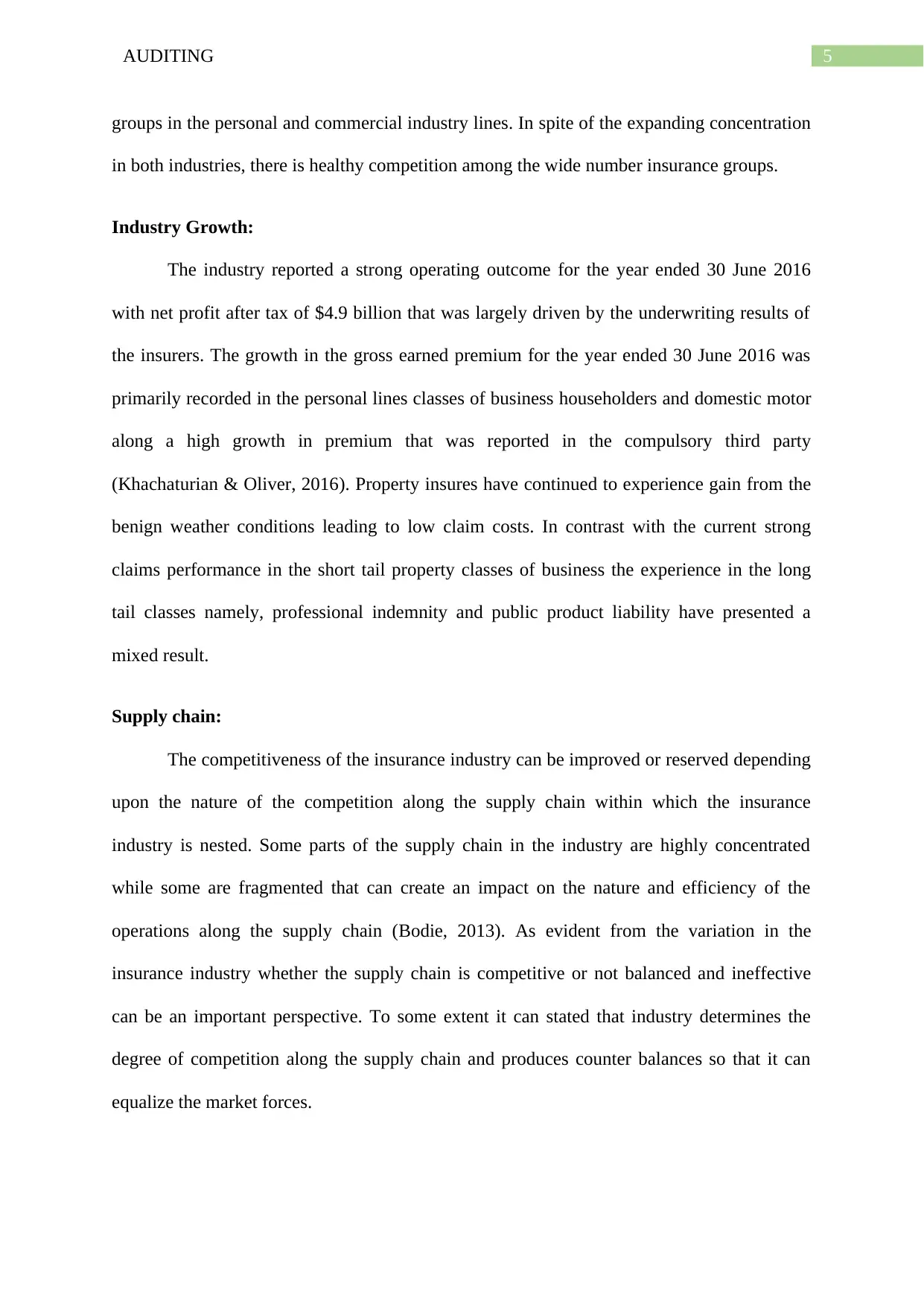
5AUDITING
groups in the personal and commercial industry lines. In spite of the expanding concentration
in both industries, there is healthy competition among the wide number insurance groups.
Industry Growth:
The industry reported a strong operating outcome for the year ended 30 June 2016
with net profit after tax of $4.9 billion that was largely driven by the underwriting results of
the insurers. The growth in the gross earned premium for the year ended 30 June 2016 was
primarily recorded in the personal lines classes of business householders and domestic motor
along a high growth in premium that was reported in the compulsory third party
(Khachaturian & Oliver, 2016). Property insures have continued to experience gain from the
benign weather conditions leading to low claim costs. In contrast with the current strong
claims performance in the short tail property classes of business the experience in the long
tail classes namely, professional indemnity and public product liability have presented a
mixed result.
Supply chain:
The competitiveness of the insurance industry can be improved or reserved depending
upon the nature of the competition along the supply chain within which the insurance
industry is nested. Some parts of the supply chain in the industry are highly concentrated
while some are fragmented that can create an impact on the nature and efficiency of the
operations along the supply chain (Bodie, 2013). As evident from the variation in the
insurance industry whether the supply chain is competitive or not balanced and ineffective
can be an important perspective. To some extent it can stated that industry determines the
degree of competition along the supply chain and produces counter balances so that it can
equalize the market forces.
groups in the personal and commercial industry lines. In spite of the expanding concentration
in both industries, there is healthy competition among the wide number insurance groups.
Industry Growth:
The industry reported a strong operating outcome for the year ended 30 June 2016
with net profit after tax of $4.9 billion that was largely driven by the underwriting results of
the insurers. The growth in the gross earned premium for the year ended 30 June 2016 was
primarily recorded in the personal lines classes of business householders and domestic motor
along a high growth in premium that was reported in the compulsory third party
(Khachaturian & Oliver, 2016). Property insures have continued to experience gain from the
benign weather conditions leading to low claim costs. In contrast with the current strong
claims performance in the short tail property classes of business the experience in the long
tail classes namely, professional indemnity and public product liability have presented a
mixed result.
Supply chain:
The competitiveness of the insurance industry can be improved or reserved depending
upon the nature of the competition along the supply chain within which the insurance
industry is nested. Some parts of the supply chain in the industry are highly concentrated
while some are fragmented that can create an impact on the nature and efficiency of the
operations along the supply chain (Bodie, 2013). As evident from the variation in the
insurance industry whether the supply chain is competitive or not balanced and ineffective
can be an important perspective. To some extent it can stated that industry determines the
degree of competition along the supply chain and produces counter balances so that it can
equalize the market forces.
⊘ This is a preview!⊘
Do you want full access?
Subscribe today to unlock all pages.

Trusted by 1+ million students worldwide

6AUDITING
Major Players:
Australian insurance industry has a large, moneymaking and well established
insurance market. Statistics represents that private insurance industry produces a gross
premium of $34.9 billion yearly with total assets of $113.9 billion (Rollins et al., 2014). In
the year 2014, the Australian insurance industry earned a $42.1 billion in terms of revenue
with a profit of $5.6 billion. Suncorp, IAG, QBE insurance and Allianz Australia Ltd are
regarded as the major players in this industry.
Market Share of Industry Players:
After the IAG’s acquistion of Wesfarmers Insurance, the australian insurance market
is obsevered to be very concentrated, even in the commercial classes together with the
liability classes as well (Bryce et al., 2016). There are three big listed insurers in Australia
that have the largest presence of mareket and comprises of approximately over 60% of the
total market. Allianze and Zurich is positioned in the second tier having a sizeable presence
of market.
Figure 1: representing Market Share occupied by Major Companies
Major Players:
Australian insurance industry has a large, moneymaking and well established
insurance market. Statistics represents that private insurance industry produces a gross
premium of $34.9 billion yearly with total assets of $113.9 billion (Rollins et al., 2014). In
the year 2014, the Australian insurance industry earned a $42.1 billion in terms of revenue
with a profit of $5.6 billion. Suncorp, IAG, QBE insurance and Allianz Australia Ltd are
regarded as the major players in this industry.
Market Share of Industry Players:
After the IAG’s acquistion of Wesfarmers Insurance, the australian insurance market
is obsevered to be very concentrated, even in the commercial classes together with the
liability classes as well (Bryce et al., 2016). There are three big listed insurers in Australia
that have the largest presence of mareket and comprises of approximately over 60% of the
total market. Allianze and Zurich is positioned in the second tier having a sizeable presence
of market.
Figure 1: representing Market Share occupied by Major Companies
Paraphrase This Document
Need a fresh take? Get an instant paraphrase of this document with our AI Paraphraser
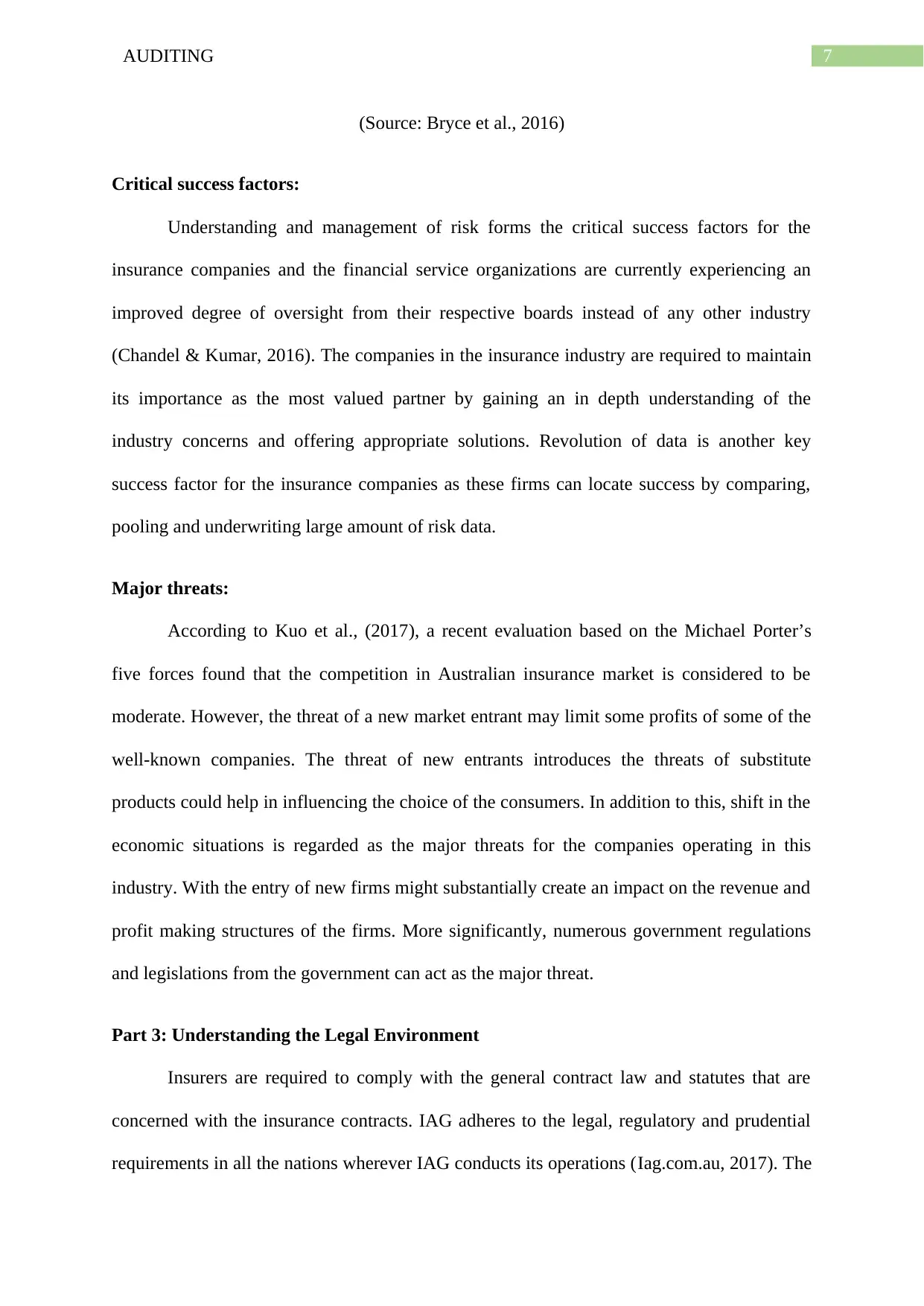
7AUDITING
(Source: Bryce et al., 2016)
Critical success factors:
Understanding and management of risk forms the critical success factors for the
insurance companies and the financial service organizations are currently experiencing an
improved degree of oversight from their respective boards instead of any other industry
(Chandel & Kumar, 2016). The companies in the insurance industry are required to maintain
its importance as the most valued partner by gaining an in depth understanding of the
industry concerns and offering appropriate solutions. Revolution of data is another key
success factor for the insurance companies as these firms can locate success by comparing,
pooling and underwriting large amount of risk data.
Major threats:
According to Kuo et al., (2017), a recent evaluation based on the Michael Porter’s
five forces found that the competition in Australian insurance market is considered to be
moderate. However, the threat of a new market entrant may limit some profits of some of the
well-known companies. The threat of new entrants introduces the threats of substitute
products could help in influencing the choice of the consumers. In addition to this, shift in the
economic situations is regarded as the major threats for the companies operating in this
industry. With the entry of new firms might substantially create an impact on the revenue and
profit making structures of the firms. More significantly, numerous government regulations
and legislations from the government can act as the major threat.
Part 3: Understanding the Legal Environment
Insurers are required to comply with the general contract law and statutes that are
concerned with the insurance contracts. IAG adheres to the legal, regulatory and prudential
requirements in all the nations wherever IAG conducts its operations (Iag.com.au, 2017). The
(Source: Bryce et al., 2016)
Critical success factors:
Understanding and management of risk forms the critical success factors for the
insurance companies and the financial service organizations are currently experiencing an
improved degree of oversight from their respective boards instead of any other industry
(Chandel & Kumar, 2016). The companies in the insurance industry are required to maintain
its importance as the most valued partner by gaining an in depth understanding of the
industry concerns and offering appropriate solutions. Revolution of data is another key
success factor for the insurance companies as these firms can locate success by comparing,
pooling and underwriting large amount of risk data.
Major threats:
According to Kuo et al., (2017), a recent evaluation based on the Michael Porter’s
five forces found that the competition in Australian insurance market is considered to be
moderate. However, the threat of a new market entrant may limit some profits of some of the
well-known companies. The threat of new entrants introduces the threats of substitute
products could help in influencing the choice of the consumers. In addition to this, shift in the
economic situations is regarded as the major threats for the companies operating in this
industry. With the entry of new firms might substantially create an impact on the revenue and
profit making structures of the firms. More significantly, numerous government regulations
and legislations from the government can act as the major threat.
Part 3: Understanding the Legal Environment
Insurers are required to comply with the general contract law and statutes that are
concerned with the insurance contracts. IAG adheres to the legal, regulatory and prudential
requirements in all the nations wherever IAG conducts its operations (Iag.com.au, 2017). The

8AUDITING
disaster reinsurance cover purchased affects the ICRC under the Australian Prudential
Regulatory Authority capital computations. Any form of new and amended risk exposure
should be approved in compliance with the IAG approval authority framework.
The company maintains a sufficient amount of diverse credit risk exposure in order to
avoid the concentration charge that is added to the regulatory capital requirement. All the
insurers within the IAG group that executes the business insurance business in Australia are
required to obtain registration with the ARPA and are subjected to the ARPA Prudential
Standards. It is the policy of IAG to make sure that each of the licenced insurers maintains
the regulatory capital (Iag.com.au, 2017). IAG makes the use of Standardised Framework laid
down in the relevant prudential standards to compute the regulatory capital.
The financial statements of IAG are prepared in compliance with the Australian
Accounting Standard Board 101 for the presentation of financial statements and ascertains
that the financial statements of the group complies with the International Financial Reporting
Standards (Iag.com.au, 2017). The financial statements of IAG are prepared based on the
principles of historical cost and the balance sheet are prepared with respect to assets and
liabilities that are broadly classified in the order of liquidity in conformity the ASIC
corporation instrument 2016/191.
Part 4: Understanding the external environment factors:
External environmental factors possess large amount of effects on the business
operations of the companies operating in the insurance industry. There are some major tools
to analyse the effects of the external environmental factors of the companies, they are PEST
Analysis, Porter’s Five Forces Analysis and SWOT Analysis. These external factors are
explained below;
disaster reinsurance cover purchased affects the ICRC under the Australian Prudential
Regulatory Authority capital computations. Any form of new and amended risk exposure
should be approved in compliance with the IAG approval authority framework.
The company maintains a sufficient amount of diverse credit risk exposure in order to
avoid the concentration charge that is added to the regulatory capital requirement. All the
insurers within the IAG group that executes the business insurance business in Australia are
required to obtain registration with the ARPA and are subjected to the ARPA Prudential
Standards. It is the policy of IAG to make sure that each of the licenced insurers maintains
the regulatory capital (Iag.com.au, 2017). IAG makes the use of Standardised Framework laid
down in the relevant prudential standards to compute the regulatory capital.
The financial statements of IAG are prepared in compliance with the Australian
Accounting Standard Board 101 for the presentation of financial statements and ascertains
that the financial statements of the group complies with the International Financial Reporting
Standards (Iag.com.au, 2017). The financial statements of IAG are prepared based on the
principles of historical cost and the balance sheet are prepared with respect to assets and
liabilities that are broadly classified in the order of liquidity in conformity the ASIC
corporation instrument 2016/191.
Part 4: Understanding the external environment factors:
External environmental factors possess large amount of effects on the business
operations of the companies operating in the insurance industry. There are some major tools
to analyse the effects of the external environmental factors of the companies, they are PEST
Analysis, Porter’s Five Forces Analysis and SWOT Analysis. These external factors are
explained below;
⊘ This is a preview!⊘
Do you want full access?
Subscribe today to unlock all pages.

Trusted by 1+ million students worldwide
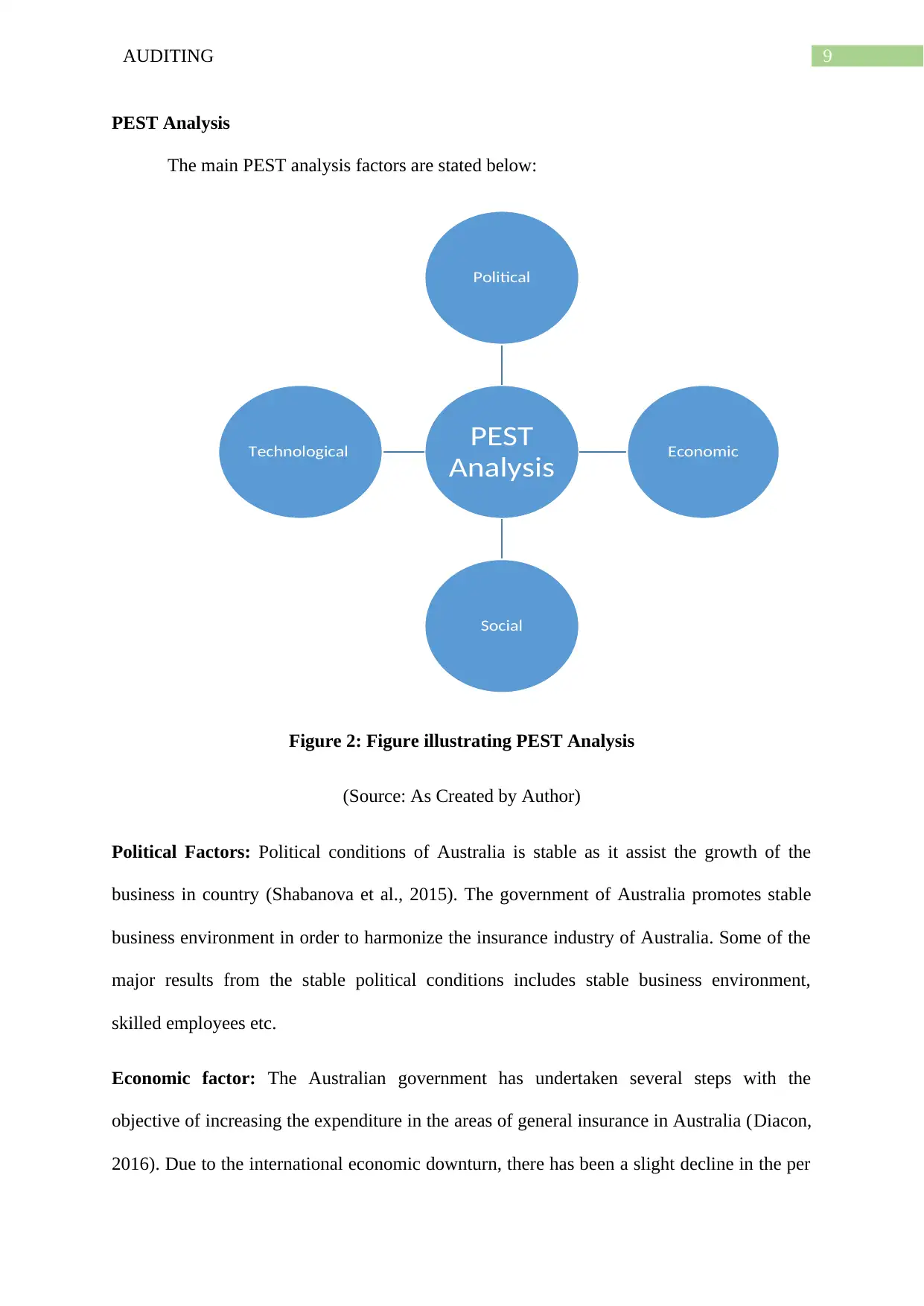
9AUDITING
PEST Analysis
The main PEST analysis factors are stated below:
Figure 2: Figure illustrating PEST Analysis
(Source: As Created by Author)
Political Factors: Political conditions of Australia is stable as it assist the growth of the
business in country (Shabanova et al., 2015). The government of Australia promotes stable
business environment in order to harmonize the insurance industry of Australia. Some of the
major results from the stable political conditions includes stable business environment,
skilled employees etc.
Economic factor: The Australian government has undertaken several steps with the
objective of increasing the expenditure in the areas of general insurance in Australia (Diacon,
2016). Due to the international economic downturn, there has been a slight decline in the per
PEST
Analysis
Political
Economic
Social
Technological
PEST Analysis
The main PEST analysis factors are stated below:
Figure 2: Figure illustrating PEST Analysis
(Source: As Created by Author)
Political Factors: Political conditions of Australia is stable as it assist the growth of the
business in country (Shabanova et al., 2015). The government of Australia promotes stable
business environment in order to harmonize the insurance industry of Australia. Some of the
major results from the stable political conditions includes stable business environment,
skilled employees etc.
Economic factor: The Australian government has undertaken several steps with the
objective of increasing the expenditure in the areas of general insurance in Australia (Diacon,
2016). Due to the international economic downturn, there has been a slight decline in the per
PEST
Analysis
Political
Economic
Social
Technological
Paraphrase This Document
Need a fresh take? Get an instant paraphrase of this document with our AI Paraphraser
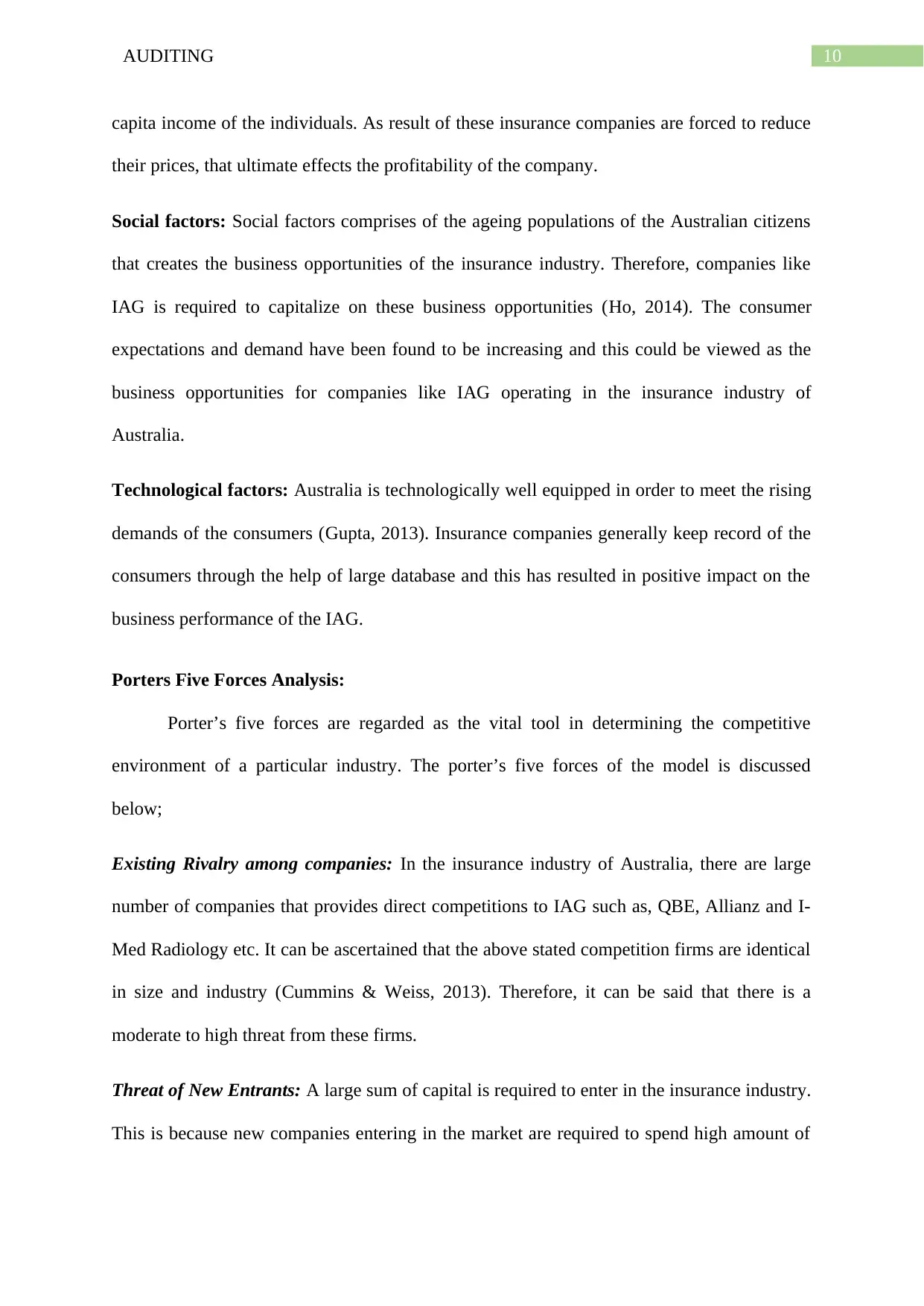
10AUDITING
capita income of the individuals. As result of these insurance companies are forced to reduce
their prices, that ultimate effects the profitability of the company.
Social factors: Social factors comprises of the ageing populations of the Australian citizens
that creates the business opportunities of the insurance industry. Therefore, companies like
IAG is required to capitalize on these business opportunities (Ho, 2014). The consumer
expectations and demand have been found to be increasing and this could be viewed as the
business opportunities for companies like IAG operating in the insurance industry of
Australia.
Technological factors: Australia is technologically well equipped in order to meet the rising
demands of the consumers (Gupta, 2013). Insurance companies generally keep record of the
consumers through the help of large database and this has resulted in positive impact on the
business performance of the IAG.
Porters Five Forces Analysis:
Porter’s five forces are regarded as the vital tool in determining the competitive
environment of a particular industry. The porter’s five forces of the model is discussed
below;
Existing Rivalry among companies: In the insurance industry of Australia, there are large
number of companies that provides direct competitions to IAG such as, QBE, Allianz and I-
Med Radiology etc. It can be ascertained that the above stated competition firms are identical
in size and industry (Cummins & Weiss, 2013). Therefore, it can be said that there is a
moderate to high threat from these firms.
Threat of New Entrants: A large sum of capital is required to enter in the insurance industry.
This is because new companies entering in the market are required to spend high amount of
capita income of the individuals. As result of these insurance companies are forced to reduce
their prices, that ultimate effects the profitability of the company.
Social factors: Social factors comprises of the ageing populations of the Australian citizens
that creates the business opportunities of the insurance industry. Therefore, companies like
IAG is required to capitalize on these business opportunities (Ho, 2014). The consumer
expectations and demand have been found to be increasing and this could be viewed as the
business opportunities for companies like IAG operating in the insurance industry of
Australia.
Technological factors: Australia is technologically well equipped in order to meet the rising
demands of the consumers (Gupta, 2013). Insurance companies generally keep record of the
consumers through the help of large database and this has resulted in positive impact on the
business performance of the IAG.
Porters Five Forces Analysis:
Porter’s five forces are regarded as the vital tool in determining the competitive
environment of a particular industry. The porter’s five forces of the model is discussed
below;
Existing Rivalry among companies: In the insurance industry of Australia, there are large
number of companies that provides direct competitions to IAG such as, QBE, Allianz and I-
Med Radiology etc. It can be ascertained that the above stated competition firms are identical
in size and industry (Cummins & Weiss, 2013). Therefore, it can be said that there is a
moderate to high threat from these firms.
Threat of New Entrants: A large sum of capital is required to enter in the insurance industry.
This is because new companies entering in the market are required to spend high amount of

11AUDITING
money in the areas of research and development (Bikker, 2016). With strong supplier base
companies generally faces low threat of new entertains in this industry.
Bargaining Power of the Buyers: Bargaining power of the consumers is relatively low with
limited number of companies with recognized operate in Australia and the buyers have very
little to choose from the firms providing service in this industry (Geneva, 2014).
Bargaining Power of Suppliers: There are ample of suppliers in the general insurance
industry. The facilities provided by the insurance companies such as large number of
suppliers generally provides medical coverage and lower premium service. Therefore, it can
be said that suppliers have higher power in this industry.
Threat of substitute: Threat of substitute products are generally low and the reason behind
this is that almost each products have identical facilities to offer. With base of suppliers it can
be said that the threat of substitute products are relatively lower.
Figure 3: Porter’s Five Forces Analysis
(Source: As created by author)
Existing Rivalry
Threat of New Entrants
Bargaining Power of Buyers
Bargainig Power of Suppliers
Threat of Substitute
money in the areas of research and development (Bikker, 2016). With strong supplier base
companies generally faces low threat of new entertains in this industry.
Bargaining Power of the Buyers: Bargaining power of the consumers is relatively low with
limited number of companies with recognized operate in Australia and the buyers have very
little to choose from the firms providing service in this industry (Geneva, 2014).
Bargaining Power of Suppliers: There are ample of suppliers in the general insurance
industry. The facilities provided by the insurance companies such as large number of
suppliers generally provides medical coverage and lower premium service. Therefore, it can
be said that suppliers have higher power in this industry.
Threat of substitute: Threat of substitute products are generally low and the reason behind
this is that almost each products have identical facilities to offer. With base of suppliers it can
be said that the threat of substitute products are relatively lower.
Figure 3: Porter’s Five Forces Analysis
(Source: As created by author)
Existing Rivalry
Threat of New Entrants
Bargaining Power of Buyers
Bargainig Power of Suppliers
Threat of Substitute
⊘ This is a preview!⊘
Do you want full access?
Subscribe today to unlock all pages.

Trusted by 1+ million students worldwide
1 out of 26
Related Documents
Your All-in-One AI-Powered Toolkit for Academic Success.
+13062052269
info@desklib.com
Available 24*7 on WhatsApp / Email
![[object Object]](/_next/static/media/star-bottom.7253800d.svg)
Unlock your academic potential
Copyright © 2020–2025 A2Z Services. All Rights Reserved. Developed and managed by ZUCOL.





